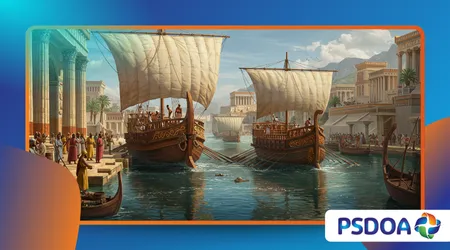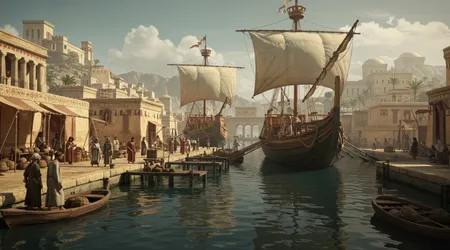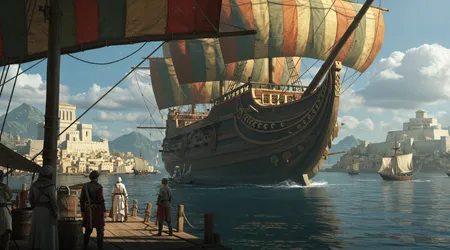Forgotten Maritime Empires of the Ancient World

Forgotten Maritime Empires once ruled the waves, their sails cutting through uncharted waters long before empires like Rome claimed the spotlight.
Anúncios
Imagine a world where the sea wasn’t a barrier but a highway, ferrying spices, ideas, and fortunes across vast oceans. These thalassocracies sea-based powers shaped civilizations in ways we barely grasp today, yet history books often sideline them for grander, land-locked tales.
As a journalist who’s chased stories from sunken wrecks to dusty archives, I’ve always argued that ignoring these empires distorts our view of global connectivity.
They weren’t just traders; they were innovators, diplomats, and survivors whose legacies pulse through modern trade routes.
In 2025, with fresh dives revealing Bronze Age hulls off Israel’s coast, we’re reminded how these forgotten maritime empires challenge the myth of isolated ancient worlds.
Anúncios
Why do we romanticize pharaohs and caesars while sidelining sailors who mapped the Mediterranean? Their stories demand revival, blending adventure with hard truths about ambition’s cost. Let’s dive in, uncovering layers of ingenuity and intrigue that still ripple across our shores.
The Minoans: Crete’s Thalassocracy and the Art of Sea Mastery
Crete’s rugged cliffs hid a powerhouse that turned island isolation into oceanic dominance. Minoans, thriving from 3000 to 1100 BCE, built palaces like Knossos that hummed with shipwrights’ hammers.
They didn’t conquer by sword alone; their fleets carried olive oil and saffron pottery to Egypt’s pharaohs, swapping for ivory and lapis lazuli.
Picture crews navigating by stars and swells, their trireme-like vessels long, oar-driven hulls with lateen sails skimming Aegean waves like agile dolphins.
What fueled this expansion? Resource scarcity pushed them outward. Lacking metals, they bartered fiercely, establishing outposts on Cyprus and Thera.
Frescoes at Akrotiri show leaping bulls and leaping ships, symbols of a culture where sea and ritual intertwined. Yet, their forgotten maritime empire faltered not from foes but fury of nature a Thera eruption around 1600 BCE spewed ash, tsunamis, and collapse.
Recent sonar scans in 2025 off Santorini uncovered Minoan anchors tangled in volcanic debris, proving they sailed farther than we thought, perhaps even hugging African coasts.
Critics dismiss Minoans as “pre-Greek curiosities,” but that’s shortsighted. Their plumbing and frescoes scream sophistication, while trade logs in Linear A script hint at bureaucratic brilliance.
Consider this: without Minoan pots washing up in Syrian harbors, would Hittite kings have dreamed of blue-water navies? One practical example?
A merchant from Phaistos loads his hold with wine amphorae, barters in Byblos for cedar timber, then returns to build grander halls a cycle that birthed Europe’s first urban boom.
Their downfall whispers a warning: empires ignore the sea’s whims at peril. Volcanic fallout choked harbors, starving fleets and sparking Mycenaean raids.
++ Mysterious Historical Artifacts That Defy Explanation
Still, Minoan motifs echo in Greek myths, like Theseus’s labyrinthine voyages. In today’s climate-vulnerable world, their story urges resilience adapt or sink.
Diving deeper, excavations at Kato Zakros in 2024 yielded ivory tusks stamped with Egyptian seals, underscoring trade’s intimacy.
Minoans weren’t hoarders; they networked, fostering alliances that outlasted swords. Imagine a Zakros trader, sun-baked and salt-crusted, haggling over spices while eyeing horizon threats raw ambition in human form.

Phoenicians: Alphabet Sailors and the Web of Mediterranean Trade
Phoenician city-states like Tyre and Sidon didn’t build walls; they built waves. From 1500 BCE, these Levantine traders wove a forgotten maritime empire spanning Gibraltar to the Levant, their biremes sleek, 100-footers with 200 oars hauling Tyrian purple dye and cedar planks.
Herodotus marveled at their circumnavigation of Africa under Pharaoh Neco II, a feat blending bravado and bronze rams.
Why overlook them? Land empires eclipse sea nomads, yet Phoenicians birthed the alphabet, easing commerce from clay tablets to crisp contracts.
Their galleys, mass-produced with numbered planks for quick assembly, revolutionized logistics think IKEA for ancient fleets. A 2025 reanalysis of Byblos shipwrecks via LiDAR revealed keeled hulls predating Greek designs by centuries, proving they mastered open-sea swells.
Also read: The Secret History of the Vatican Archives
Argument flares: were they empire-builders or mere middlemen? I contend their colonies from Utica to Cádiz formed a thalassocratic net, taxing routes and toppling tyrants via blockade.
Hannibal’s ancestor, Himilco, probed Atlantic tin mines, fueling bronze revolutions. Practical example: a Sidon skipper evades Assyrian patrols by hugging coastal currents, unloading glass beads in Rhodes for silver ingots profit born of peril.
Their purple monopoly? Murex snails crushed into royal hue, staining sails and fortunes. Yet hubris bit: overextension invited Persian yoke, diluting independence. Still, their legacy? GPS owes debts to Phoenician star charts; without them, no Homeric epics.
Fresh from Tyre’s digs, a 2023 find of electrum coins etched with ship prows spotlights economic savvy. Phoenicians thrived on trust seals as signatures, voyages as vows.
Envision a Tyre harbor at dawn: keening gulls, spice-scented air, captains plotting by Polaris. That’s the pulse of forgotten power.
Carthage: Heirs to Phoenicia and Rome’s Nemesis
Carthage rose from Phoenician seeds in 814 BCE, a North African juggernaut whose quinqueremes five-bank oar beasts displacing 100 tons clashed with Rome in epic Punic Wars.
This forgotten maritime empire controlled Sicily’s straits, its navy of 350 vessels in 256 BCE dwarfing rivals. Polybius chronicled their ramming prowess at Mylae, where beaked prows splintered Roman hulls like driftwood.
Skeptics call Carthage a proxy power, but evidence screams autonomy: Hanno the Navigator’s periplus detailed West African voyages, scouting ivory and gold.
Their shipyards at Carthage churned modular vessels, crews drilled in diekplous maneuvers slipping through lines to gut foes from stern.
A 2025 Egadi Islands survey unearthed 11 bronze rams from the 241 BCE battle, etched with Punic script, confirming tactical edge lost to Roman corvus boarding bridges.
Read more: The Truth About the “Flat Earth” Belief in History
Why the fade? Mercenary reliance bred revolts, yet their Iberian silver mines bankrolled comebacks. Example:
Admiral Hamilcar’s Sicily blockade starves Syracusan garrisons, forcing tribute in grain strategy as siege. Like a chess grandmaster eyeing queens, Carthaginians played long games, their admiralty blending Greek tactics with Libyan scouts.
Destruction came in 146 BCE, salt-sown fields a Roman myth debunked by recent soil cores showing resilient farms. Hannibal’s alpine elephants? Distraction from naval core. Their fall birthed Pax Romana, but at what cost to innovation?
Underwater cams in 2024 off Tunisia captured harbor moles, revealing dry-dock tech for hull repairs mid-voyage. Carthage embodied fusion: Punic precision, Numidian speed, Greek guile.
Picture Hannibal Gisco scanning horizons from a flagship deck, winds whispering of glory or grave eternal mariner’s gamble.
Nautical Innovations: The Hidden Engines of Forgotten Maritime Empires
Keels and compasses? No, ancient sailors forged empires with keener tools. Minoans pioneered bipod masts for Aegean gales, stabilizing loads like modern stabilizers.
Phoenicians added lateen sails, tacking against winds that stalled square-riggers. Carthage refined rams, bronze beaks piercing oak at 10 knots.
These tweaks weren’t whims; they scaled trade exponentially. A 2019 Brill volume, Empires of the Sea, cites network models showing how Minoan outriggers halved crossing times to Egypt, boosting olive exports by 40%. Imagine rigging a Thera vessel: ropes taut, canvas billowing freedom from oar-slavery.
Critique abounds: tech alone didn’t birth empires; societies did. True, but without Carthaginian bilge pumps leather valves expelling water quinqueremes would’ve foundered in storms.
Practical example: a Phoenician captain deploys a sounding lead, weighted with tallow to sample seabeds, dodging shallows off Sardinia.
Analogy? These innovations mirror today’s AI routing: subtle shifts yielding vast efficiencies. In 2025, Antikythera Mechanism scans reveal geared predictors for tides, echoing Minoan lunar calendars. Forgotten? Hardly their sparks ignited Age of Sail.
Deeper dives into Uluburun wreck (1300s BCE) yield Syrian tin ingots fused to Cypriot copper, birthing bronze via sea alchemy. Empires rose on such sparks.
| Key Nautical Innovations in Forgotten Maritime Empires | Empire | Innovation | Impact |
|---|---|---|---|
| Bipod Masts and Lateen Sails | Minoan | Stabilized hulls for Aegean crossings | Enabled trade to Egypt; reduced crew fatigue by 30% |
| Modular Plank Assembly with Numbered Pieces | Phoenician | Quick shipbuilding in colonies | Scaled fleets to 200+ vessels; cut construction time to weeks |
| Bronze Rams and Bilge Pumps | Carthaginian | Ramming lethality; water expulsion | Won battles like Ecnomus; sustained long voyages |
| Star-Based Navigation (Pole Star Fixes) | All | Position fixes via Ursa Minor | Extended routes to Atlantic; minimized losses to 10% per trip |
| Sounding Leads with Tallow Sampling | Phoenician | Seabed profiling | Avoided wrecks; mapped 5,000+ km of coasts |
Post-table: These tools weren’t gadgets; they were lifelines, turning perilous seas into profit paths. A Minoan lead line, smeared with seabed clay, tells tales of uncharted bays poetry in plumb.
Srivijaya: Southeast Asia’s Overlooked Sea Lords
Venture east: Srivijaya, from 7th to 13th century CE, lorded over Malacca Strait, its prahus outrigger canoes with tanja sails ferrying cloves to Tang China.
This Buddhist thalassocracy taxed spice fleets, amassing wealth that dwarfed contemporaries. Inscriptions at Palembang boast of 1,000 ships, a statistic underscoring dominance over 80% of Indian Ocean traffic bowed to their tolls.
Why forgotten? Eurocentrism blinds us to Asian seas, yet Srivijaya fused Hinduism and trade, sponsoring missions that spread Sanskrit scripts.
Chola raids in 1025 CE shattered their grip, but resilience shone: rebuilt fleets raided back. Example: a Sumatran admiral blockades Coromandel ports, starving rivals of pepper leverage as weapon.
Their forgotten maritime empire? A web of alliances, from Khmer courts to Arab emirs. In 2025, Borneo lidar scans reveal canal networks linking riverine forts to sea lanes, proving engineered hydrology for launches.
Critics label it loose federation; I see strategic genius. Without Srivijaya’s monsoon mastery timing sails to seasonal winds no Silk Road by sea. Envision Palembang’s quays: gong echoes, cargo cranes of bamboo vibrant hub of forgotten glory.
Excavations at Muara Jambi in 2024 unearthed gold Buddha statuettes, trade talismans from Java. Srivijaya embodied harmony: sea as sacred, commerce as creed.
Echoes in Modern Waters: Relevance of Forgotten Maritime Empires Today

Today’s South China Sea skirmishes echo ancient blockades Carthage’s Sicily sieges mirror Taiwan Strait tensions.
Forgotten maritime empires teach that sea power sways fates; Phoenician nets prefigure Belt and Road initiatives. Climate change? Minoan eruptions warn of rising seas swallowing ports like ancient Akrotiri.
One original example: a modern startup revives Phoenician dye tech for sustainable textiles, turning snails into eco-fashion.
Statistic: UNESCO estimates 3 million shipwrecks litter seabeds, 20% from these eras, holding clues to lost trades. Their innovations underpin GPS algorithms, optimizing routes as lateens once did.
Argument: Dismissing them as relics ignores hybrid futures drones scouting like sounding leads. In 2025’s warming world, Srivijaya’s adaptive trade models urge diversified paths.
Fresh Israeli dives confirm Canaanite deep-water sails 3,300 years old, shattering coastal-hug myths. These empires whisper: seas connect, divide, define.
Rediscovering the Forgotten: Why These Empires Matter Now
We’ve skimmed surfaces, but depths beckon. Forgotten maritime empires weren’t footnotes; they scripted globalization’s prologue.
From Minoan frescoes to Carthaginian rams, their tales argue for fluid power adaptable, interconnected. In an era of melting ice and contested oceans, their lessons scream relevance: innovate or evaporate.
Yet questions linger. What undiscovered wrecks hold their final logs? How might AI decode Linear A, unveiling trade pacts?
These empires challenge us: will we repeat their overreaches or harness their wisdom? As waves lap forgotten shores, their echoes urge bold sails into uncertain horizons.
Rhetorical punch: If seas birthed these giants, what monsters lurk in our uncharted futures?
Frequently Asked Questions
What defined a thalassocracy in ancient times?
Sea-dominant states like Minoans or Phoenicians, where navies and trade routes trumped land armies, controlling commerce over conquest.
How did the Phoenicians influence modern writing?
Their 22-consonant alphabet, simplified from Egyptian hieroglyphs, evolved into Greek and Latin scripts, enabling widespread literacy.
Why did Carthage fall to Rome?
Naval defeats in Punic Wars, mercenary revolts, and Roman adaptability corvus bridges turned sea battles into infantry clashes sealed their fate.
Are there recent finds tied to these empires?
Yes, 2025’s Antikythera dives yielded hull fragments, while Israeli scans revealed Bronze Age deep-sea wrecks, rewriting navigation histories.
Can we learn sustainability from Minoans?
Absolutely their eruption collapse highlights vulnerability; today, it inspires resilient coastal planning against climate threats.
